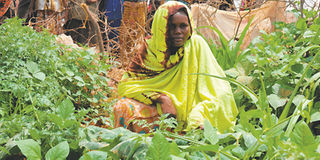Struggle to feed eight children in a refugee camp

Ms Husna Mohammed, a refugee, looks after her vegetables at Dagahaley Refugee Camp in Dadaab, North Eastern Province. Photo/WFP
The current food shortage might soon be declared a national disaster, but one refugee does not take hunger lying down.
With eight children and an ninth one soon, Ms Husna Mohammed, 30, is taking charge of her plates of food at Dagahaley in Dadaab Refugee Camp in North Eastern Province.
She keeps a vegetable garden outside her tent to supplement her food ration. Refugees at this camp receive food rations every two weeks. The amount given depends on the family size.
“I am five months pregnant, so I also require the vegetables to get vitamins for my baby,” she told the Nation at the camp at the weekend.
The food rations include cereals, pulses, vegetable oil, salt and corn-soya. But the mother of eight also grows beans, potatoes, pumpkins and maize, and serves the greens for breakfast.
The maize sometimes fails, but the pumpkin leaves are a reliable source of breakfast. The refugee camp lacks piped water, but she makes use of water from her daily chores to water her little garden.
Husna is among 332,023 refugees hosted in Dadaab, the biggest refugee complex in the world.
The three satellite camps, Ifo, Hagadera and Dagahaley, were initially set up to host 90,000 refugees fleeing the war in Somalia.
Arrivals per day
According to the UN refugee agency, the influx of refugees with 2,000 new arrivals per day has led to a demand in space, forcing the refugees to encroach on community land that might breed conflict.
Husna is lucky to have a tent. Her neighbours make do with huts made of twigs and sheets as shelter.
Her children help water the garden whenever they get water from the watering hole at the camp, where patience is a critical virtue, since queues are long.
“I miss planting my own food in Somalia,” she says. She was a farmer before war made her a refugee. But Husna would rather be growing crops on this small garden than in her expansive farm in Somalia.
Drought and two decades of violence have forced Somalis to flee their country and take refuge at the three Dadaab camps, where the face of drought is manifested by famished and unproductive animals.
Only a handful of refugees own livestock and crop growing is a dream in this camp.
In January, the Food and Agriculture Organisation of the United Nations told of a possible food crisis this year.
Researchers argue that declaring hunger a national disaster would enable the government to mobilise its machinery to have food delivered to the people.
Acute malnutrition now affects at least one in every four people in parts of northeastern, the UN adds.
Dr Lusike Wasilwa, assistant director, horticulture and industrial crops at the Kenya Agricultural Research Institute’s horticulture is confident that food security is achievable if farmers are closely monitored and advised on the use of drought resistant crops.
“Agriculture is the backbone of this country and a sector we should not give up on,” Dr Wasilwa said in an interview.
The researcher gives an example of the horticulture industry that has been able to cushion itself from some of the adverse weather effects.
Another researcher, Dr Joseph Karugia expresses concern that with the Kenyan population doubling every 17 years, there was an urgent need to come up with urgent solutions to Kenya’s food situation.
In parts of Africa, falling food production, rising food costs and the resulting food insecurity are increasingly common as droughts and floods, for example, become more frequent, he notes.
Dr Karugia advises that integrating regional food staple markets and improving transport links will make food distribution cheaper and faster.
For Husna, a dose of vegetable per day keeps her family going, though she hopes one day she will freely farm on a larger piece of land.




